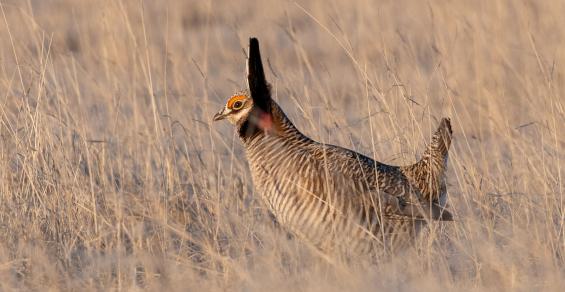Cattle producers are concerned with rollout of lesser prairie chicken regulations under the Endangered Species Act.
Environmental groups continued pressure on the U.S. Fish and Wildlife Service to list the Lesser Prairie Chicken as “threatened” under the Endangered Species Act is one issue that just won’t seem to expire.
The most recent salvo in this game of chicken came on Nov. 25, when USFWS published its final rule to list the Lesser Prairie Chicken as “threatened” in Kansas, Colorado, Oklahoma and parts of Texas; and as “endangered” in New Mexico and other parts of Texas. The one concession to the agricultural industry in this listing was the 4(d) rule, which grants protection to routine agricultural practices on cultivated land in the threatened zone. But that ruling specifically excluded livestock grazing practices from those protections against huge fines and criminal penalties. That is, unless a rancher follows a site-specific grazing plan that has been developed by a USFWS-approved third party.
That’s why at their meeting, Dec. 2, Kansas Livestock Association members approved policy that supports including grazing lands under the 4(d) rule, and cutting that third-party approval of their grazing plans.
Who’s the third party?
This is the sticking point for KLA members, explained Aaron Popelka, vice president of legal and governmental affairs for KLA. He spoke after the KLA meeting at a small press conference with Sen. Roger Marshall (R-Kan.) and Ken White of White Exploration, an oil and gas company, in Wichita, Kan.
“For ranchers, the sole individuals — who are the reason this bird continues to exist in Kansas — to continue their operations without the threat of fines from USFWS, we have to get a third-party approved grazing plan signed off on by someone approved by the USFWS,” he said. For example, the extraordinary drought cattle producers have faced required on-the-ground decisions moment by moment regarding stocking rates and other management, Popelka said. This rule now requires someone from Washington, D.C., to approve those decisions. That’s offensive to KLA members, who have been doing the conservation work on their lands to not only manage them for cattle grazing, but also to help wildlife like the Lesser Prairie Chicken, he said.
Even more concerning for KLA is the fact that as of Dec. 2, there were zero third-party organizations approved by FWS to approve any grazing management plans, Popelka said. The logical partner, the USDA Natural Resources Conservation Service, hasn’t been approved. And KLA Environmental Services, which works with cattle producers on environmental plans, hasn’t been approved. Popelka said members are concerned that anti-animal agriculture groups could be approved third parties. And that has far-reaching consequences beyond the Lesser Prairie Chicken’s status.
Timing uncertain
This USFWS ruling also comes four to six months before cattle producers need to make their controlled burn management plans, and five to six months before cattle producers turn out their herds for spring grazing. Considering the USFWS doesn’t quite know how this ruling will be implemented, or what agencies or organizations will be responsible to approve grazing plans — or even how long that approval process will take — it could cause a lot of uncertainty among ranchers. They may not know if they can graze the land in the manner they choose, Popelka said. And with drought already reducing herd numbers, this adds more uncertainty to the cow-calf segment.
For his part, Marshall plans to introduce legislation after the rule goes into effect Jan. 24 that calls for a congressional review of the USFWS ruling. This, he said, doesn’t have to go through committee and just requires 51 votes to pass. On the House side, Rep. Tracey Mann (R-Kan.) plans to introduce legislation that says before any species is added to the Endangered Species Act, Congress needs to approve it, taking the authority from the agency. The Kansas delegation also wants the GAO (Governent Accountability Office) to release its findings in issuing this report to be transparent about the science this ruling is based upon, Marshall said.
In all of this, there’s one question that needs to be asked, Marshall said: “What do you have to do to get the chicken off the list?”
If populations rebound after the rains return and the drought passes, like they have in the past, will the Lesser Prairie Chicken be taken off the list?




